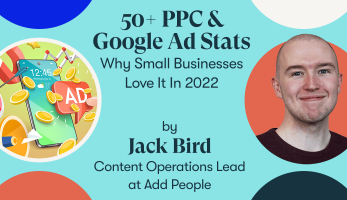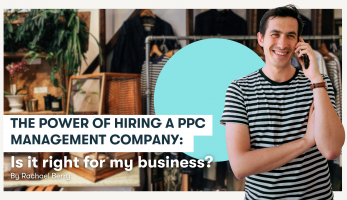What is PPC advertising?
PPC advertising, or Pay-Per-Click advertising, is a digital marketing model where advertisers pay a fee each time one of their ads is clicked.
It’s a way of buying visits to a website rather than earning those visits organically through search engine optimization (SEO).
PPC ads can appear on various platforms, with the most popular being search engines like Google, Bing, and Yahoo, as well as on social media platforms like Facebook, Twitter, and LinkedIn.
PPC advertising offers several advantages, including immediate visibility in search results, precise audience targeting, and the ability to control the budget.
However, it requires ongoing management and optimization to ensure cost-effectiveness and achieve the desired marketing goals.
The secret to a successful PPC campaign
Set clear goals and objectives
Before diving into your PPC campaign, define specific and measurable goals.
Are you aiming to increase website traffic, generate leads, or boost sales?
Understanding your objectives will guide your campaign structure and budget allocation.
Having clear goals provides focus and direction to your campaign efforts.
Without specific objectives, you run the risk of having aimless campaigns that don’t deliver meaningful results.
You will also want to set a benchmark of what success looks like for your campaign.
By setting specific, measurable, achievable, relevant, and time-bound (SMART) objectives, you can easily track the progress of your campaign.
Research your target audience and keywords
Research is a crucial part of planning your PPC campaign and setting it up for success.
Truly understanding your target audience allows you to create highly relevant and targeted campaigns whilst also ensuring your ad spend is spent on the right keywords.
By knowing their demographics, interests, and behaviours, you can tailor your ad copies and offers to resonate with their specific needs and preferences.
It is worth bearing in mind that researching your target audience and keywords is not a one-time thing.
It should be regularly reviewed as customer behaviour and trends change, continuous research allows you to adapt your PPC campaign and remain relevant in your market, bringing long-term success.
Choose the right PPC platform
Businesses should familiarise themselves with the major PPC platforms available, such as Google Ads, Bing Ads, Facebook Ads, Instagram Ads, Twitter Ads, LinkedIn Ads, and more.
Each platform has its own strengths and weaknesses and unique features.
Research and define your target audience by considering factors such as demographics, interests, behaviours, and online habits.
Different platforms attract different user groups, so making sure your audience aligns with the platform is crucial.
Another thing to consider is your industry.
For instance, Facebook and Instagram are great for e-commerce and visually appealing products, while LinkedIn is better for B2B targeting.
Finally, businesses should examine the ad formats each platform offers.
Google Ads has text ads, display ads, and video ads, while social media platforms offer image, video, carousel, and story ads.
Choose a platform that aligns with the type of content you want to promote.
Craft compelling ad copy
The key to compelling ad copy is to effectively communicate the value proposition of your product or service in a concise and engaging way.
Continuously refine your ad copy based on data and feedback to achieve the best possible results from your PPC campaigns.
Knowing your audience and their pain points, needs, and desires will help you craft copy in a way that resonates with them and plays on their emotions and motivations.
Highlighting the benefits and value of your product will also entice your audience.
This could be done through attention-grabbing headlines, featuring USP’s (unique selling points), including facts and figures, and creating a strong CTA (call to action).
Finally, Instead of just listing features, explain how those features solve a problem or fulfil a need for the user.
Show them how your product/service improves their life.
Optimise landing pages
Optimising landing pages ensures that users have a positive experience after clicking your ads.
When users find what they’re looking for and encounter a user-friendly, relevant landing page, they’re much more likely to convert.
Moreover, platforms like Google Ads consider landing page quality when determining your Quality Score, which affects your ad positions and costs.
A well-optimized landing page contributes to better overall campaign performance and ROI.
An example of this is that your landing page will be scored on a range of things such as its alignment with the ad copy.
This means the messaging, keywords, and design should align, ensuring users find what they’re expecting when they click through.
Monitor and analyse campaign performance
Continuous monitoring and analysing of your campaign is essential for success.
Being in tune with your campaign allows you to make decisions driven by data instead of relying on assumptions.
It also allows you to highlight underperforming areas and make adjustments to optimise your campaign which will also ensure your budget is being used in the best areas.
If you also track your competitor’s performance, you can also identify opportunities to outperform them or adjust your strategy based on their tactics.
With PPC, any tweaks you make to your campaign are live in real-time, preventing wasted ad spend.
Stay up to date with industry trends
Staying up to date with industry trends is paramount in today’s rapidly evolving business landscape.
It enables businesses to remain competitive, adapt to changing consumer behaviours, and capitalize on emerging opportunities.
By being aware of the latest technological advancements, shifts in consumer preferences, and updates in marketing strategies, businesses can make informed decisions that resonate with their target audience.
Industry trends often guide innovation and provide insights into what works and what doesn’t, helping companies refine their strategies, enhance customer experiences, and maintain relevance.
In the dynamic world of digital marketing, staying informed about industry trends ensures that businesses remain agile, proactive, and well-positioned to navigate challenges while leveraging new avenues for growth.
Negative keywords and quality score
Negative keywords and Quality Score are both pivotal elements in the success of a PPC campaign.
Negative keywords play a crucial role in refining your campaign’s targeting by preventing your ads from showing up for irrelevant or unrelated search queries.
By eliminating these unwanted clicks, you not only save on ad spend but also ensure that your ads are presented to a more qualified audience, ultimately boosting your campaign’s efficiency and driving higher-quality traffic.
Quality Score, on the other hand, significantly influences the visibility and cost-effectiveness of your ads.
A high-quality score is indicative of the relevance and overall quality of your ads, keywords, and landing pages.
It not only leads to improved ad rankings, ensuring your ads appear in prime positions but also contributes to lower costs per click and conversion.
By prioritizing both negative keywords and Quality Scores, businesses can optimize their PPC campaigns for increased ROI, better user experience, and a competitive edge in the digital advertising landscape.
Want to grow your business through PPC marketing?
Managing a successful PPC campaign demands a strategic approach, continuous monitoring, and a commitment to optimization.
Remember, the journey doesn’t end once the campaign is launched; it’s an ongoing process of learning, refining, and innovating.
So, seize the opportunity to drive targeted traffic, boost conversions, and elevate your business’s online presence through the power of PPC advertising.
Start your journey towards PPC success today by crafting impactful campaigns that resonate with your audience and lead to remarkable results.
Embrace the possibilities, and let your business soar to new heights!




